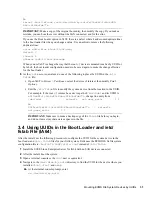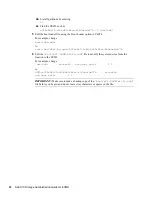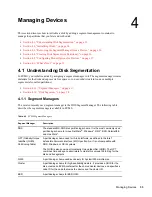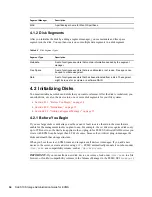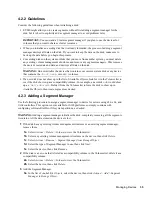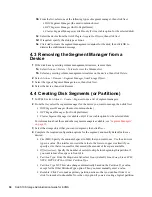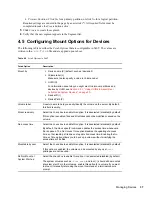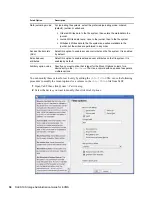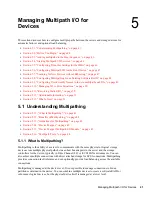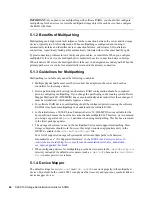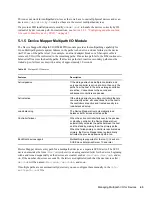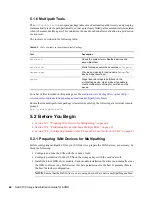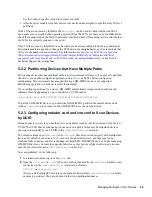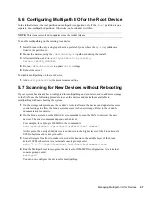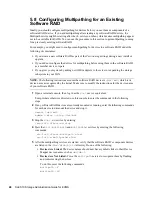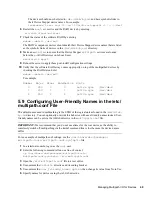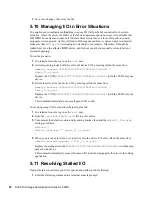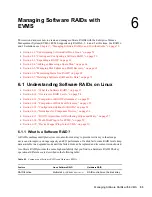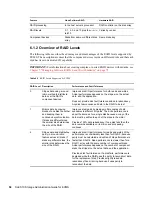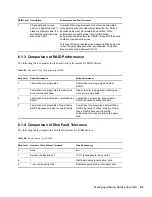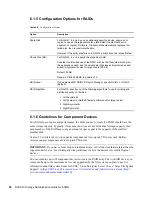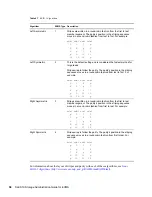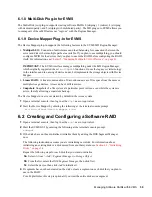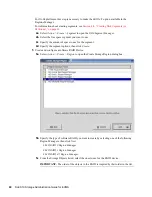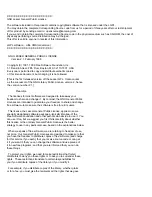
Managing Multipath I/O for Devices
45
no
vd
ocx (
E
NU)
9
Jan
uar
y 2
007
See the vendor’s specific instructions for more details.
After the driver module is loaded, discover the device nodes assigned to specific array LUNs or
partitions.
If the LUNs are not seen by the HBA driver,
lsscsi
can be used to check whether the SCSI
devices are seen correctly by the operating system. When the LUNs are not seen by the HBA driver,
check the zoning setup of the SAN. In particular, check whether LUN masking is active and whether
the LUNs are correctly assigned to the server.
If the LUNs are seen by the HBA driver, but there are no corresponding block devices, additional
kernel parameters are needed to change the SCSI device scanning behavior, such as to indicate that
LUNs are not numbered consecutively. For information, see
Options for SCSI Device Scanning
(http://www.novell.com/support/search.do?cmd=displayKC&docType=kc&externalId=http--
supportnovellcom-techcenter-sdb-en-2005-06-drahnscsiscanninghtml&sliceId=)
in the Novell
Technical Support Knowledgebase.
5.2.2 Partitioning Devices that Have Multiple Paths
Partitioning devices that have multiple paths is not recommended. However, if you want to partition
the device, you should configure its partitions using
fdisk
or YaST2 before configuring
multipathing. This is necessary because partitioning a DM-MPIO device is not supported.
Partitioning operations on md# devices fail if attempted.
If you configure partitions for a device, DM-MPIO automatically recognizes the partitions and
indicates them by appending p1-p
n
to the device’s UUID, such as
/dev/disk/by-id/3600601607cf30e00184589a37a31d911
p1
To partition DM-MPIO devices, you must disable DM-MPIO, partition the normal device node
(such as
/dev/sdc
), then reboot to allow DM-MPIO to see the new partitions.
5.2.3 Configuring mdadm.conf and lvm.conf to Scan Devices
by UUID
Strange behavior occurs if you use the device node names (such as /dev/sdc) instead of the device’s
UUID. The UUID does not change by reboot or when a path is failed over. Multipathed devices
show up automatically by their UUID in the
/dev/disk/by-id
directory.
The default settings in
mdadm.conf
and
lvm.conf
files do not work properly with multipathed
devices. By default, both
md
and
LVM2
scan only the physical devices, and they ignore any
symbolic links to devices and Device Mapper multipath I/O (DM-MPIO) devices. When managing
DM-MPIO devices, you want the opposite behavior, so they ignore all physical devices, and scan
only the devices listed in the
/dev/disk/by-id
directory.
To avoid problems, do the following:
1
In a terminal console, log in as the
root
user.
2
Open the
/etc/mdadm.conf
file in a text editor, then modify the
Devices
variable to scan
for devices in the
/dev/disk/by-id
directory, as follows:
DEVICE /dev/disk/by-id/*
After you start multipath I/O services, the paths are listed under
/dev/disk/by-id
as these
names are persistent. They are identical to their non-multipathed names.
Summary of Contents for LINUX ENTERPRISE SERVER 10 - STORAGE ADMINISTRATION GUIDE FOR EVMS
Page 4: ...novdocx ENU 9 January 2007 ...
Page 8: ...8 SLES 10 Storage Administration Guide for EVMS novdocx ENU 9 January 2007 ...
Page 10: ...10 SLES 10 Storage Administration Guide for EVMS novdocx ENU 9 January 2007 ...
Page 40: ...40 SLES 10 Storage Administration Guide for EVMS novdocx ENU 9 January 2007 ...
Page 52: ...52 SLES 10 Storage Administration Guide for EVMS novdocx ENU 9 January 2007 ...
Page 74: ...74 SLES 10 Storage Administration Guide for EVMS novdocx ENU 9 January 2007 ...
Page 84: ...84 SLES 10 Storage Administration Guide for EVMS novdocx ENU 9 January 2007 ...

